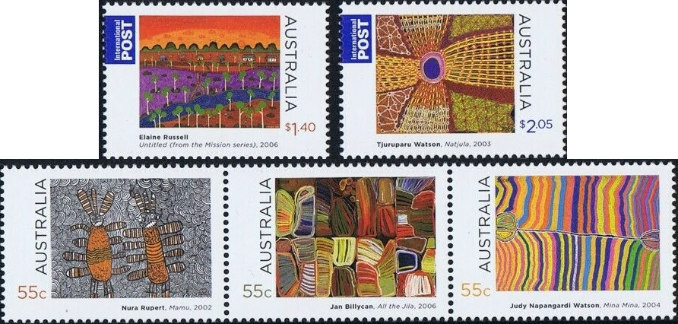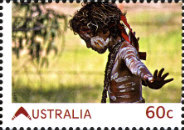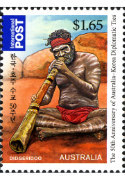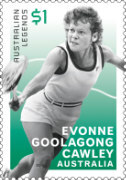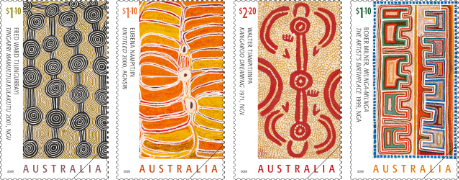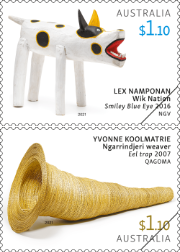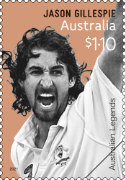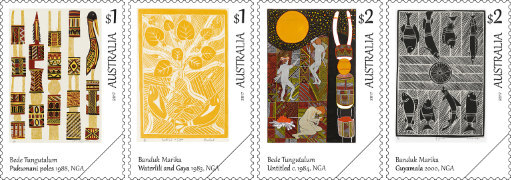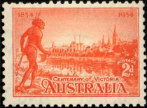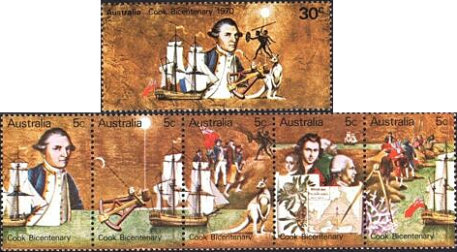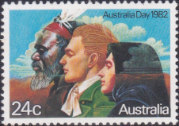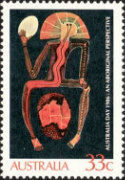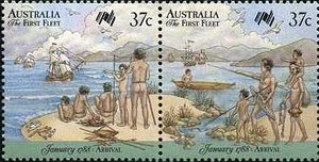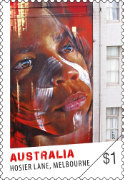Aboriginal timeline: Arts
Found 131 results for your search. Showing page 6 of 7.
2009
-
Australia Post releases five stamps featuring paintings by five Aboriginal artists: Nura Ripert (Mamu), Jan Billycan (All the Jila), Judy Napangardi Watson (Mina Mina), and for the international stamps Elaine Russell (Untitled [Mission Series]) and Tjuruparu Watson (Natjula).

The works of five Aboriginal artists represent Aboriginal culture on national and international stamps.
2011
-

To avoid stereotypes, Australia Post could have opted for a more contemporary representation of Aboriginal culture for this stamp. As part of its Living Australian issue Australia Post issues a stamp with the image of a young Aboriginal boy. The photo is titled Little Man's Business and was taken by Suzanne Wilson of New South Wales.
-

An identical stamp was issued in Korea to celebrate the relationship with Australia. Australia Post issues a stamp showing an Aboriginal didgeridoo player for the 50th anniversary of the Australian–Korean relationship which was forged during the Korean War. Official diplomatic relations begun in 1961 and developed into a strong partnership. The other stamp shows a Haegeum musician.
2016
-

Tennis legend Evonne Goolagong-Cawley was the first Australian woman to win Wimbledon in 1971. One stamp of Australia Post's Australian Legends of Singles Tennis issue features Wiradjuri woman Evonne Goolagong Cawley AO MBE. She won four Australian Open singles between 1974 and 1977 and Wimbledon in 1971 and 1980. When she finished her career in the mid-1980s she had seven Grand Slam singles titles from 18 finals, and 13 major titles in all.
2020
-
In its Art of the Desert issue, Australia Post features works by Aboriginal artists from the Western Desert region. Two were associated with the Warlayirti Artists in Balgo, Western Australia (Boxer Milner [Milnga-Milnga, the artist's birth place 1999] and Eubena Nampitjin [Untitled 2000]) and two with the artists’ cooperative at Papunya Tula, Northern Territory (Fred Ward Tjungurrayi [Tingarri Mamultjulkulakutu (Tingarri men travelling to Mamultjulku) 2001] and Walter Tjampitjinpa [Kangaroo Dreaming 1971]).

The artworks show paintings of the Arlayirti Artists (WA) and Papunya Tula (NT) artist cooperatives.
2021
-

The works of Lex Namponan and Yvonne Koolmatrie show contemporary Aboriginal art. In its Australian Contemporary Sculpture issue, Australia Post shows one artwork of Lex Namponan, a Wik man from Aurukun, QLD, who is renown for his milkwood sculptures of camp dogs. The dog is a sacred totem for the clan, and his works, such as the laughing Smiley Blue Eye, combine cultural significance with popular market appeal. The other artwork is from Yvonne Koolmatrie, a Ngarrindjeri woman from South Australia. She is a master grass weaver, and her wide-ranging subjects include animals, human figures, planes and hot-air balloons, as well as traditional objects such as Eel trap, featured on the stamp.
-

Jason Gillespie is one of the 'Legends of Cricket'. The Australian Legends of Cricket stamp issue celebrates six players, among them Kamilaroi man Jason 'Dizzy' Gillespie, the first Aboriginal man to play cricket for Australia. Gillespie played all three formats of cricket – Test, One Day and Twenty20. He retired in 2008.
2017
-
Art of the North celebrates works by two eminent Aboriginal artists from the northern regions of Australia’s Northern Territory, Banduk Marika and Bede Tungutalum. The stamps show Pukumani Poles (1988), Waterlili and Gaya (1983), Untitled (c.1984) and Guyamala (2000).

The four stamps selected to represent Aboriginal art of the north of Australia.
1934
-

One of the earliest Australian stamps with a reference to Aboriginal culture. The 1934 stamp issue shows an Aboriginal man with spears walking towards a river that separates him from the town beyond, almost as if to show the contrast between pre and post invasion conditions. There were three denominations to the set.
1970
-
A stamp issue for Australia's 200th anniversary of "first European contact" at the east coast centres around Captain Cook. A mini sheet issued by Australia Post annotates the third stamp of the series (which shows Aboriginal people in the top right corner) with "where he finds new people and strange animals", conveniently omitting conflict.

The Bicentenary issue put Aboriginal people into the far background. Can you spot them?
1982
-

The Australia Day 1982 stamp tried to convey a sense of unity of diverse Australians. A stamp for Australia Day shows the head of an Aboriginal man, along with that of a European colonist and an immigrant. The stamp's design symbolises the three waves of migration to Australia: Aboriginal people from south-east Asia, the British and European post-war immigrants.
1986
-

A Wandjina spirit protects the land. This stamp issue shows the continent of Australia cradled and protected by a Wandjina spirit. He holds a second egg in his hand, a symbol of perfection and rebirth. It also refers to the unbroken (and still misunderstood) Aboriginal spirit and how the land owns its people.
1988
-

Aboriginal people's reception of the First Fleet was not as passive and peaceful as shown here. Two stamps of the Australia Day issue show an Aboriginal family watching the arrival of the First Fleet. They are relaxed and just looking on, a misrepresentation of the resistance Aboriginal people showed when they first encountered the British.
2017
-

Artist Adnate is well known for his giant art works which often feature Aboriginal subjects. One stamp in Australia Post's Street Art issue shows artist Adnate’s large-scale work in Hosier Lane, Melbourne. The City of Melbourne commissioned this 23 metre mural of an Aboriginal boy in 2014. As in this portrait, Adnate’s subjects are often members of Aboriginal communities, and the artist has done a significant amount of fundraising work in this area.
2020
-
APY man Vincent Namatjira, great-grandson of renown artist Albert Namatjira, wins the Archibald prize with a portrait of himself and AFL legend Adam Goodes titled Stand Strong for Who You Are and becomes the first Aboriginal artist to win the prize in its almost 100-year history.
Indigenous art isn't just dot paintings ... We do everything – music, film, photography, contemporary art. We do it all, and we do it really well.
— Vincent Namatjira [1] -
Wongutha-Yamatji man and first-time Archibald Prize entrant Meyne Wyatt wins the 2020 Packing Room Prize with his self portrait, titled Meyne. It is the first time an Aboriginal artist has won any of the awards in the Archibald prize's history. (The Packing Room Prize is judged by gallery staff who receive, unpack and hang the entries submitted to the Archibald prize.)
-
For the first time DNA data technology is used to preserve moving images for archival purposes, and for the first time an Australian video is encoded on DNA. The video chosen is that of Cathy Freeman running – and winning – the 400m Olympic race in 2000, and on this day projected onto the Sydney Opera House.
2021
-
Artist and Pitjantjatara man Timo Hogan wins the 2021 Telstra Art Award in the National Aboriginal and Torres Strait Islander Art Awards, Australia's longest-running Aboriginal art awards, with his painting ‘Lake Baker’ which depicts a creation story related to this sacred place.
-
Gamilaroi artist Travis De Vries claims to have created the first Aboriginal non-fungible token (NFT) with his artwork Tear it Down (Cook Falling). He offers it for 1770 Tezos (tez) coins, a digital currency.
-
Actor and Yolngu man David Dalaithngu (AM), as his family whats him to be known now, dies aged 68 after a long fight with lung cancer. He starred in movies like, among others, Walkabout (1971), Storm Boy (1976), Crocodile Dundee (1986), Rabbit Proof Fence (2002), The Tracker (2002), Ten Canoes (2006), Charlie’s Country (2013) and My Name is Gulpilil (2021).
David Dalaithngu was more than just Australia’s first great Indigenous actor. He was one of the country’s finest actors from any culture at any time.
— Sydney Morning Herald [2]
References
View article sources (0)
[138596] 'Navigating History: Endeavour Voyage 250 Years', Australia Post 29/4/2020, available at australiapostcollectables.com.au/stamp-issues/navigating-history-endeavour-voyage-250-years.html
[146807] ''It took 99 years': Vincent Namatjira wins Archibald prize', SMH 26/9/2020
[118788] Product description on JB Hi-Fi website, available at www.jbhifi.com.au/products/cd-midnight-oil-makarrata-project-the-cd
[136482] 'First ever all-black shows: Australian Fashion Week showcases Indigenous talent – video', The Guardian 5/6/2021
[155924] 'A ‘rock star’ trailblazer who was an inspiration for Indigenous actors and filmmakers', SMH 30/11/2021
